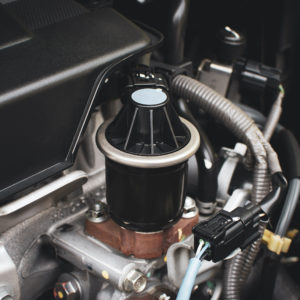The exhaust gas recirculation (EGR) system returns exhaust gasses to the engine in an effort to reduce combustion temperatures and limit the emissions of nitrogen oxides (NOx). On some diesel vehicles, the EGR system runs the exhaust through a cooler to lower combustion temperatures even further.
The PCM checks the temperature of the exhaust gas coming from the EGR cooler. It will log a P2457 code if the exhaust temperature does not meet the expected value.
What Does the P2457 Code Mean?
The diagnostic trouble code (DTC) P2457 indicates “Exhaust Gas Recirculation Cooling System Performance.” It applies to certain diesel vehicles equipped with an EGR cooler.
The EGR system is a vital part of the emission control system in some diesel-engined vehicles. It helps reduce the NOx levels by routing inert exhaust gasses back to the engine to lower combustion temperatures.
A EGR cooler is sometimes used to cool the exhaust gasses before they enter the engine. The EGR cooler relies on coolant borrowed from the engine cooling system to remove heat from the gasses.

As the gasses pass through the EGR cooler, the heat they carry gets absorbed by the coolant. The fluid goes to the radiator and vents the heat while the now-cooled exhaust goes into the intake manifold. There, the exhaust mixes with fresh air and enters the engine to get burned anew.
The PCM regularly checks the EGR cooling system to see if the latter is doing its job. If the computer doesn’t get the right response, it will set the generic code P2457.
Note: The definition of code P2457 can differ according to the vehicle manufacturer. Check the appropriate repair manual or repair database for the exact code definition.

What are the Common Causes of the P2457 Code?
- Blocked EGR cooler
- Leak or restriction in the engine coolant system
- Faulty EGR temperature sensor
- Restricted charge air cooler
What are the Common Symptoms of the P2457 Code?
- Illuminated check engine light
- Vehicle stuck in “limp mode”
How to Diagnose the P2457 Code
The P2457 code is a generic code that various makes and models can log. However, this does not mean that there is a one-size-fits-all solution to identify its underlying problem.
If you’re not confident about conducting diagnostic tests on your vehicle, it’s a good idea to bring it to a professional mechanic. Otherwise, you can go ahead and diagnose the issue yourself.
How to Fix the P2457 Code
Attempting to fix a P2457 code can become challenging if you don’t have the right tools and know-how to test the EGR cooler. In most cases, it’s best to leave the job to professionals.
For DIYers with advanced technical knowledge and hands-on experience who prefer to test and replace their vehicle’s EGR cooler on their own, it will be helpful to rely on the appropriate repair manual or refer to an online repair database.
Any information provided on this Website is for informational purposes only and is not intended to replace consultation with a professional mechanic. The accuracy and timeliness of the information may change from the time of publication.


















